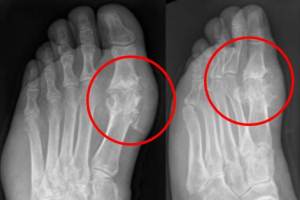 Once considered the “disease of kings” and wealthy aristocrats, gout is becoming a much more common problem throughout the western world today. Gout is a painful condition caused by a buildup of uric acid crystals in the body’s soft tissues and joints. Recurrent bouts of gout can lead to “gouty arthritis,” which is a degenerative type of chronic arthritis. Like all forms of arthritis, pain management is uppermost in the minds of health practitioners, and chiropractic treatment for gout is centered around non-invasive, drug-free therapies.
Once considered the “disease of kings” and wealthy aristocrats, gout is becoming a much more common problem throughout the western world today. Gout is a painful condition caused by a buildup of uric acid crystals in the body’s soft tissues and joints. Recurrent bouts of gout can lead to “gouty arthritis,” which is a degenerative type of chronic arthritis. Like all forms of arthritis, pain management is uppermost in the minds of health practitioners, and chiropractic treatment for gout is centered around non-invasive, drug-free therapies.
According to the 2007-2008 National Health and Nutrition Examination Survey (NHANES) gout affects upwards of 3.9 percent of the American population, and hyperuricemia (an excess of uric acid in the blood, which is a precursor to gout) affect 21.5 percent. The typical western lifestyle is blamed for the increased incidence of the disease, as gout is triggered by a diet that includes a lot of alcohol, meat and shellfish. Some common medications may also contribute to gouty arthritis. Individuals with diabetes, high blood pressure, or those who are obese are at greater risk of contracting the disease.
The pain and inflammation from gout is caused when the kidneys are unable to remove enough of the uric acid that is formed as a result of the metabolism of purines, which are a compound commonly found in many high-protein foods. The uric acid buildup causes the formation of sharp, needle-like crystals, which are deposited in the soft tissues surrounding the joints, causing pain, swelling, heat and redness. Although gout can affect any joint, most initial attacks of gout occur in the lower extremities, particularly in the joint of the big toe.
The most common approach to treating gout is to prescribe medications, anti-inflammatory drugs and steroids to manage pain. While this may work on a short-term basis, it may also cause unwanted side effects. In contrast, the chiropractic treatment of gout usually involves a combination of advice about diet and lifestyle changes along with chiropractic manipulation to reduce pain and address the cause of the disease without the use of drugs.
Your chiropractor will likely advise that you reduce your intake of meat and alcohol and increase your intake of foods that have been shown to lower the concentration of uric acid in the blood, such as cherries. Half a pound of cherries per day is the recommended amount to eat if you are looking to lower uric acid levels. However, you can also drink concentrated cherry juice or take cherry juice extract to achieve the same results if cherries are out of season or eating that many is not to your taste. Quercetin, a flavonoid found in such foods as apples, berries and onions, inhibits the production of uric acid, so your chiropractor may also suggest that you include more of these in your diet as well. Herbs that support kidney function (like couch grass) may also be recommended, since they may help your kidneys work more efficiently to clear the blood of excess uric acid.
In combination with these, your chiropractor may perform adjustments or manipulations using heat and/or ultrasound to help bring the body back into alignment and relieve pain.

